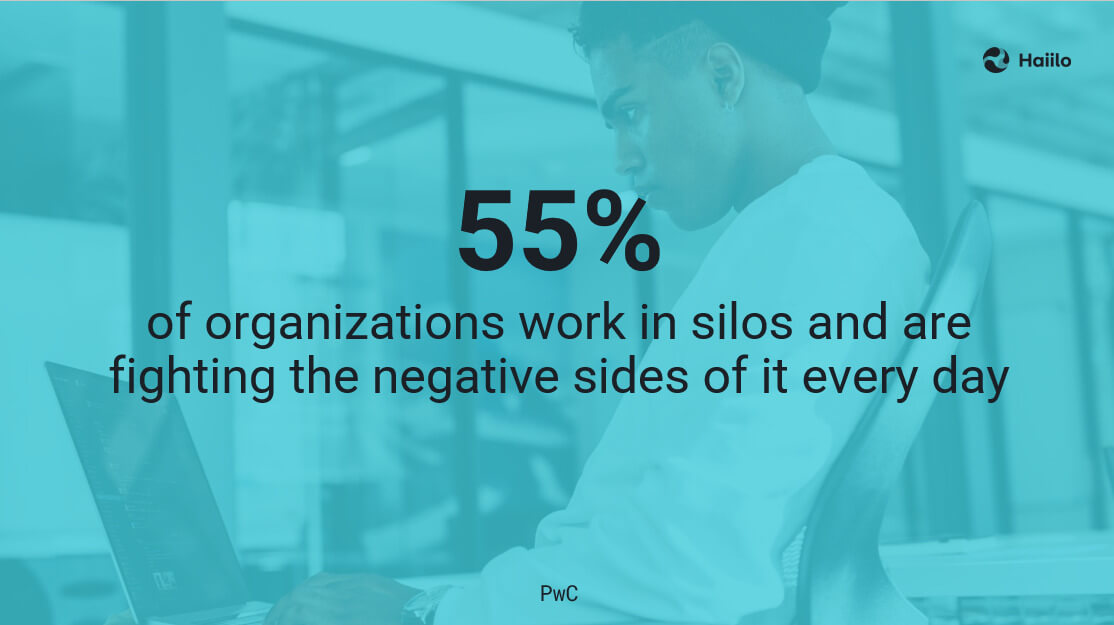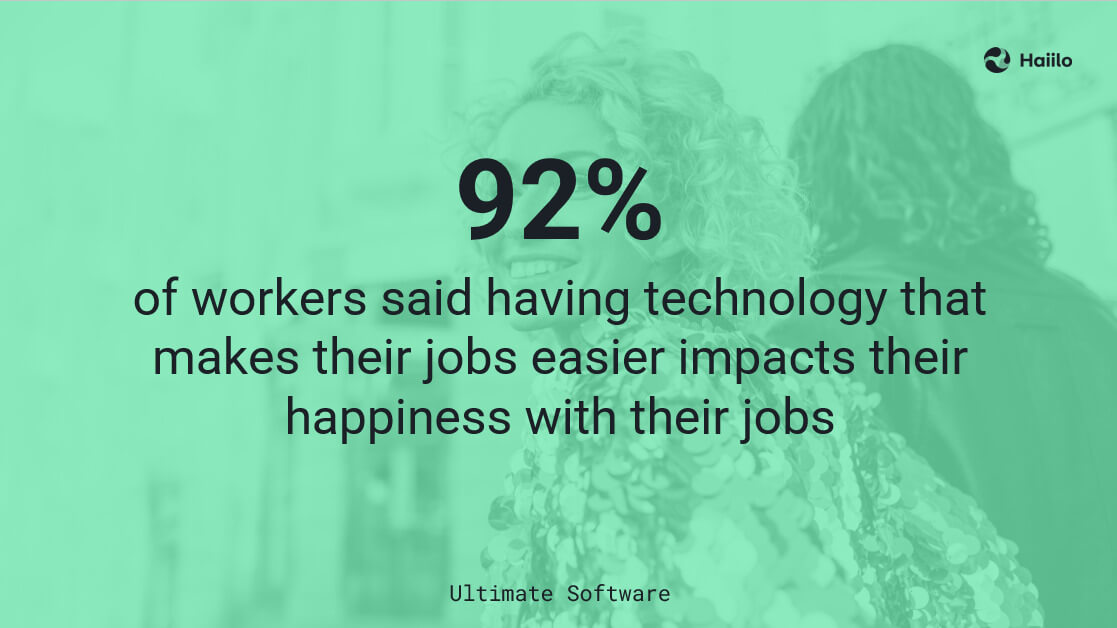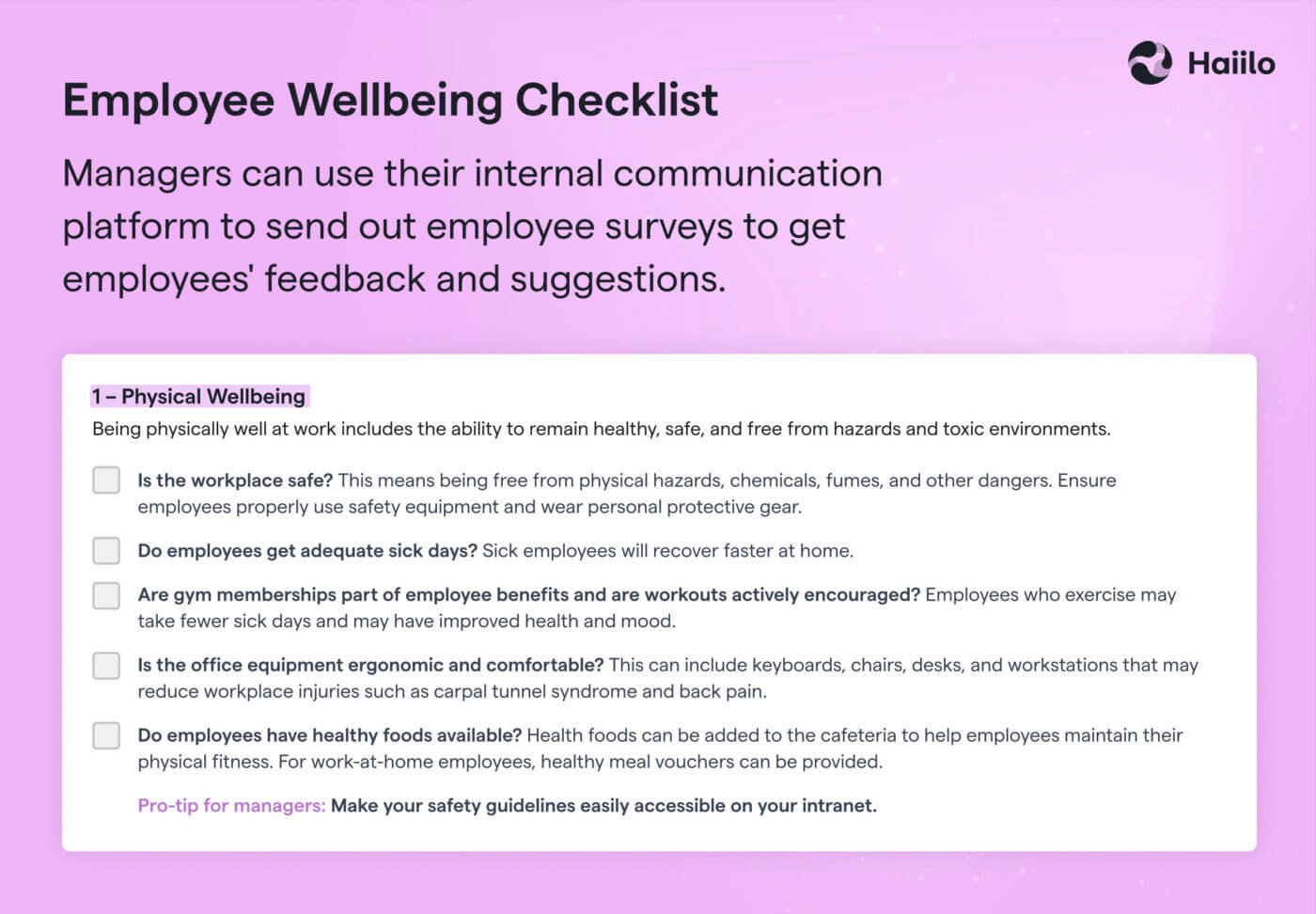Breaking down silos is critical for organizational success and business continuity. With the increasing importance of cross-functional collaboration, organizations are tasked with enabling their workforce to collaborate efficiently and work together toward achieving common goals.
In PWC’s survey of global operations managers, 61% cited cross-functional collaboration as being the key to helping the company reach strategic goals.
However, according to PwC survey, 55% of organizations work in silos and are fighting the negative sides of it every day. Working in silos obstructs communication, impacts employee productivity, leads to bitterness and poor employee well-being.

If you are looking for ways to break down silos in your company, keep reading this blog, where we will cover 9 best practices to do so.
- 1. Drive Organizational Alignment by Communicating a Unified Vision
- 2. Set Common Goals and Objectives
- 3. Foster Cross-Functional Collaboration and Build Balanced Interdepartmental Relationships
- 4. Form Cross-Functional Teams
- 5. Open Up Lines of Communication
- 6. Create Engaging Employee Communities
- 7. Eliminate the Biggest Communication Barriers
- 8. Ask Your Employees How to Break Down the SIlos
- 9. Implement the Right Technology
1. Drive Organizational Alignment by Communicating a Unified Vision
Every company works hard to define its mission and vision. But not many employees understand what their organization’s “North Star” is.
According to research, 52% of employees don’t know what their company’s vision is. This is surprising because many employers are aware of the strong link between financial performance and the extent to which employees believe in their company’s values.
Breaking down silos is impossible if employees are not aligned with the company’s vision and don’t know what their company stands for.
So it is critical that internal communications departments, together with leaders, continuously evaluate organizational alignment and frequently communicate their company’s vision and mission to the entire workforce.
Break down silos in your company with Haiilo communications platform!
2. Set Common Goals and Objectives
Once you have your mission and vision defined, the next step is to define common goals and objectives that align with the company’s strategy to achieve its vision.
Unfortunately, IBM found that 72% of employees don’t have a full understanding of their company’s strategy and what it takes to get there.
Common cross-departmental goals and objectives can go a long way in breaking down silos in organizations as they encourage more collaboration and teamwork.
When every department has its own independent goals, employees might become dismissive of and/or oblivious to what other people in the organization are working on and how they can help each other to achieve greater results together.
3. Foster Cross-Functional Collaboration and Build Balanced Interdepartmental Relationships
Projects with strong cross-functional collaboration or executive support have a 76% success rate, according to Stanford-based transformational leadership expert Behnam Tabrizi. But success drops to 19% when projects have only moderate cross-functional support.
This is particularly important for remote and hybrid workplaces where people don’t have a chance to communicate in person but depend on technology to do so.
Department leaders need to be aligned and come up with a strategy for collaboration. They can, for example, organize cross-departmental weekly calls, create cross-departmental channels for communication, implement sophisticated collaboration technology, celebrate big wins together, and even organize in-person QBRs (quarterly business reviews).
4. Form Cross-Functional Teams
To enable better interdepartmental teamwork even further, you could create designated cross-functional teams. A good example would be a cross-functional team of people from the marketing, sales, and customer success departments.
These professionals often need to work together in order to achieve more impactful results. Oftentimes, they need to share and transfer knowledge with each other on a daily basis.
According to Deloitte’s findings:
“The shift from hierarchies to cross-functional teams is well underway. Our data shows that adopting team structures improves organizational performance for those that have made the journey; organizations that have not risk falling further behind.”
In fact, organizations that move to cross-functional teams found that 53% experienced a significant improvement in performance, and 31% reported that most or almost all of their work was being done in teams.

5. Open Up Lines of Communication
Your internal communication strategy is critical for breaking up silos in your organization. IC and HR departments are responsible for managing and nurturing company-wide employee communications and building trust in the workplace.
📹 Check out our Masterclass about the importance of having an internal communications strategy!
However, many IC departments are stuck in the days where they send monthly or weekly generic employee newsletters to share the biggest company updates. Due to crowded inboxes with irrelevant emails, many employees ignore these emails and never engage with their company’s content.
Instead, employee communications should be more personalized and relevant to the workers. By using targeted employee communications software, communication professionals can segment their audience by language, location, department, level of seniority and much more to make sure employees are engaged with the content they receive.
6. Create Engaging Employee Communities
In their private lives, most people are members of some type of community. In organizations, marketers and customer success professionals also create communities every day.
But what about employee communities?
This is a relatively new term we described in our recent blog as:
“a virtual social-media-like place where employees come together to connect, communicate, and collaborate with each other. It serves as a single hub for employees to access information, share knowledge, ask questions, provide feedback, find documents, and collaborate with peers. It streamlines internal communications, strengthens relationships between employees, and provides quick access to the resources they need.”
40% of people say that they feel isolated at work, resulting in lower organizational commitment, engagement, and silos.
So creating, managing, and nurturing engaged internal communities can go a long way in ensuring workplace transparency and eliminating organizational silos. They help employees stay connected, encourage teamwork, boost interdepartmental communication, and ensure easy access to important information employees need on a daily basis.
7. Eliminate the Biggest Communication Barriers
In most cases, organizational silos happen due to common communication barriers in the workplace. To break down the silos, employers need to understand these barriers and focus on tackling them.
For example, you could evaluate your organizational structure and hierarchy to understand their impact on workplace communications. If this is causing silos between departments, consider simplifying your communication hierarchy so that people feel free to talk to anyone in the organization.
You could also evaluate the main communication channels in your company. Understand which channels work best for synchronous versus asynchronous communication, and make sure that you provide as much visibility and transparency as possible.
Sometimes, organizational silos can also be caused by the lack of communication skills among employees. If this is the case, consider investing in communication courses to help your employees develop their communication skills.
8. Ask Your Employees How to Break Down the SIlos
If you absolutely don’t know how to start tackling silos in your company, ask your employees for help. Not only that encouraging employees’ share of voice builds trust in the workplace, but it can be the best way to find the root cause of silos in your company.
Consider putting together a simple employee survey asking employees to name and describe situations where they felt like their department or team struggled to work on a cross-departmental project. Make sure that you distribute the survey using the right channels so that you reach as many employees as possible and get a better response rate.
Ideally, your survey solution should already give you valuable insights and actionable recommendations for improvement.
9. Implement the Right Technology
Proper workplace technology has a direct impact on employee experience and job satisfaction. According to a study by Ultimate Software, 92% of workers said having technology that makes their jobs easier impacts their happiness with their jobs.

Although 75% of team leaders and employees rate teamwork and communication as pivoting for the success of projects, not every company has the necessary tools to enable better collaboration and eliminate organizational silos.
Furthermore, the right communication technology plays a critical role in connecting employees and boosting their engagement. For instance, video conferencing solutions help is a good alternative to important water cooler chats in-office employees have. Likewise, dedicated messaging channels help cross-functional teams cut through the noise and collaboratively work on important projects. Most importantly, employee communication platforms are designated tools for enabling internal comms professionals to keep their workforce informed, engaged, and aligned, making it a must-have tool for breaking down silos in organizations.










